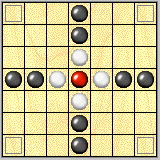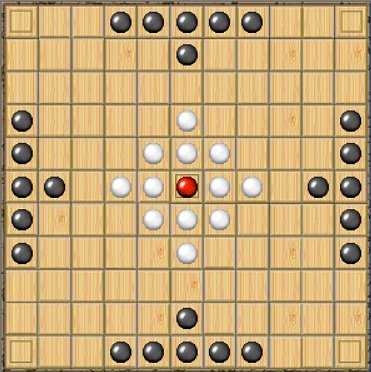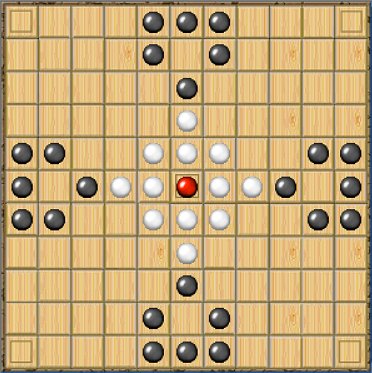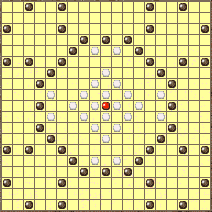

In Tablut (also Hnefatafl ) the Black
side is laying siege to the kingdom of the White side. The object
for the White side is to move his King (“Hnefi”) to
one of the corner squares, in which case he has successfully
escaped. The object for the Black side is to capture the White
King. Black makes the first move. All pieces move like a Rook in
chess, that is, any number of squares horizontally or vertically.
No pieces, except the King, may land on the corner squares or the
centre square. The centre square is the King’s throne or
“Konakis”.
Tablut employs orthogonal interception-capture. When an
enemy piece is surrounded on two opposite sides, the piece is
captured. The corner and centre squares also act like friendly
pieces. Thus, if an enemy piece is sandwiched between a friendly
piece and these special squares, this also results in capture.
Capture is not mandatory. Note that the central square
only functions as capture square when it’s empty. (In an
alternative variant, it needn’t be empty to function as
capture square.) The same capture rules applies also to the King,
except when it is positioned on the centre square, when it must
be surrounded on all four sides. If the King is positioned on any
of the four squares adjacent to the centre, it must be surrounded
on three sides, plus the centre square, which then functions as a
capture-square.
Tablut boards and pieces are often found in Viking graves. Pieces
are typically made of bone, glass, or amber. The game had a rich
history in Viking tales. In one such story King Knut and
Jarl Ulf were playing, and Knut made a mistake allowing Ulf
to capture a piece. Knut requested that he be allowed to take
back his move. Ulf refused, toppling the board, and an argument
ensued that ended when Ulf was killed. The Swedish botanist
Carolus Linnæus, the inventor of the system for
classifying plants and animals we still use today, wrote about
Tablut in his diary in 1732. He discovered it during his travels
in Lapland, where the game had survived and was still played
among the Lapps. The side with the King represented the Swedes,
while the other side respresented Moscovites.
Watch out whenever a piece is positioned orthogonally adjacent to
an opponent’s, as it’s liable to get captured.
Exchanging pieces early in the game would generally benefit White
rather than Black, because White needs open space to escape with
his King. Black should keep the position crowded. Both sides
should look out for King moves that allow the King two different
paths to the rim, since it will be impossible to block both
directions at the same time.
Five variants have been implemented: Tablut (9x9), Brandubh
(7x7), Large Hnefatafl (13x13), Tawlbwrdd (13x13) and Alea
Evangelii (19x19). Tablut (above image) seems to be a
well-balanced game. It’s a tough nut to crack, although
Black should probably win in the end. In Brandubh (below)
White can sometimes achieve a rapid win, but Black’s
chances seem slightly better. White could build a fortress,
making the king invulnerable, with the intent of repeating moves
within the fortress. But this only means that White has lost;
since there is no way out and there are only two results: win or
lose. If White repeats moves, he loses, too.
Tablut and Large Hnefatafl derive from Scandinavia and are
probably more original than Brandubh and Alea Evangelii (The
Evangelic Game), which were played on the British islands. In
Alea Evangelii the rules differ somewhat, and White starts the
game. This implementation follows the rules researched by the
Historical Museum, Stockholm, and it shows what a sophisticated
game Tablut is. It was immensely popular during the Viking
era.
There are two other versions of the game, with similar rules,
namely the British gwyddbwyll and the Irish
fidhchell. They figure in many stories in the Celtic
tradition. The corner squares were regarded as the four
Otherwordly cities to which the Tuatha de Danaan arrive.
It was a godlike idealized people around which many heroic
stories revolve. On the gaming board, which was also the land,
the center is regarded as sacred and called Tara, the seat
of High Kings. As the mystical fifth dimension it represented the
Otherworld itself, which was always proximate, and overlying
reality (cf. Matthew, C., “The Celtic
Tradition”, pp.9-10).
 Brandubh (“black raven”)
is Irish and is quite a sophisticated game. It is much more
complicated than one would expect.
Brandubh (“black raven”)
is Irish and is quite a sophisticated game. It is much more
complicated than one would expect.
 Large Hnefatafl derives from
Scandinavia. A game of this size would probably call for training
from early age. It appears that Viking boys trained
“swimming and playing tafl”. Tafl is the oldest name
for Hnefatafl.
Large Hnefatafl derives from
Scandinavia. A game of this size would probably call for training
from early age. It appears that Viking boys trained
“swimming and playing tafl”. Tafl is the oldest name
for Hnefatafl.
 Tawlbwrdd was played in Wales. Only
the setup differs from Large Hnefatafl.
Tawlbwrdd was played in Wales. Only
the setup differs from Large Hnefatafl.
 Alea Evangelii (“The
Evangelical game”) derives from 10th century England.
Christian interpreters viewed it as an allegory of the
Evangelists. The primarius vir (the king) symbolized the
unity of the Trinity. In reality it was played on the
intersections of an 18x18 board, which makes 19x19 positions
(actually, a Go board). The rules for this variant are different.
If the white King reaches the rim the game is won. The whole
periphery functions as capture square. White makes the first
move.
Alea Evangelii (“The
Evangelical game”) derives from 10th century England.
Christian interpreters viewed it as an allegory of the
Evangelists. The primarius vir (the king) symbolized the
unity of the Trinity. In reality it was played on the
intersections of an 18x18 board, which makes 19x19 positions
(actually, a Go board). The rules for this variant are different.
If the white King reaches the rim the game is won. The whole
periphery functions as capture square. White makes the first
move.
References
Murray, H.J.R. (1952). A History of Board-Games Other Than
Chess.
‘Tafl games’. Wikipedia article. (here)
See also: Breakthru – a modernized version of medieval Tafl (here).
☛ You can download my free Tablut program here (updated 2025-05-15), but you must own the software Zillions of Games to be able to run it. (I recommend the download version.)
© Mats Winther 2006